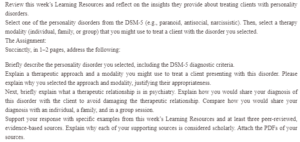Antisocial Personality Disorder
Antisocial personality disorder is a psychiatric condition in which an individual constantly shows no regard for wrong or right while ignoring the feelings and rights of other individuals (Gedeon et al., 2019). Individuals with this disorder have callous indifference; they tend to manipulate, oppress, or harshly treat others. According to the DSM-V diagnostic, at least three symptoms must exist since the age of 15 years. The symptoms include failure to conform to social norms, deceitfulness, impulsivity, irritability and aggressiveness, reckless disregard for safety, consistent irresponsibility, and lack of remorse (American Psychiatric Association, 2013).
Cognitive-behavioral therapy can be used in the treatment of Antisocial personality disorder. CBT will involve introducing conditional and unconditional beliefs, restructuring intermediate beliefs, and behavioral experiments (Sargın et al., 2017). Cognitive strategies will help patients build a healthy adult mode, and patients must, however, realize their modes and then challenge them. Examples of cognitive strategies that can be used include testing schema validity, assessing the benefits and limitations of patients’ coping strategies, and using schema diaries (Sargın et al., 2017).
A therapeutic alliance is a consistent and close interaction between the patient and their therapist (Totura et al., 2018). A therapeutic alliance allows the patient to get better, and it allows the patient to share their intimate thoughts with their therapist, forming the basis of a successful therapy session. The best way to announce a diagnosis is by being empathetic. The therapist should put themselves in the patient’s shoes and not be judgemental. Creating a trusting and non-judgemental environment before sharing a diagnosis in a family or group session is essential.
All the articles used in this assignment are scholarly. They have been published in reputable psychiatry journals. They are peer-reviewed, and the language is professional. The affiliations of the authors have been indicated. The information has also been cited.
References
American Psychiatric Association. (2013). Diagnostic and statistical manual of mental disorders (DSM-5®). American Psychiatric Pub.
Gedeon, T., Parry, J., & Völlm, B. (2019). The role of oxytocin in antisocial personality disorders: A systematic review of the literature. Frontiers in Psychiatry, 10. https://doi.org/10.3389/fpsyt.2019.00076
Sargın, A. E., Özdel, K., & Türkçapar, M. H. (2017). Cognitive-behavioral theory and treatment of antisocial personality disorder. Psychopathy – New Updates on an Old Phenomenon. https://doi.org/10.5772/intechopen.68986
Totura, C. M., Fields, S. A., & Karver, M. S. (2018). The role of the therapeutic relationship in Psychopharmacological treatment outcomes: A meta-analytic review. Psychiatric Services, 69(1), 41-47. https://doi.org/10.1176/appi.ps.201700114
ORDER A PLAGIARISM-FREE PAPER HERE
We’ll write everything from scratch
Question
Review this week’s Learning Resources and reflect on the insights they provide about treating clients with personality disorders.

Antisocial Personality Disorder
Select one of the personality disorders from the DSM-5 (e.g., paranoid, antisocial, narcissistic). Then, select a therapy modality (individual, family, or group) that you might use to treat a client with the disorder you selected.
The Assignment:
Succinctly, in 1–2 pages, address the following:
Briefly describe the personality disorder you selected, including the DSM-5 diagnostic criteria.
Explain a therapeutic approach and a modality you might use to treat a client presenting with this disorder. Please explain why you selected the approach and modality, justifying their appropriateness.
Next, briefly explain what a therapeutic relationship is in psychiatry. Explain how you would share your diagnosis of this disorder with the client to avoid damaging the therapeutic relationship. Compare how you would share your diagnosis with an individual, a family, and in a group session.
Support your response with specific examples from this week’s Learning Resources and at least three peer-reviewed, evidence-based sources. Explain why each of your supporting sources is considered scholarly. Attach the PDFs of your sources.

